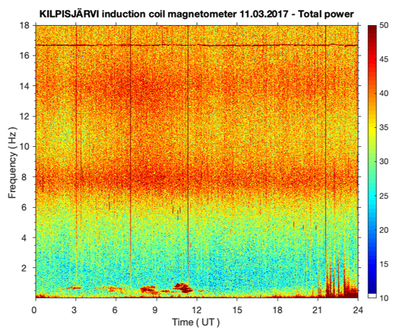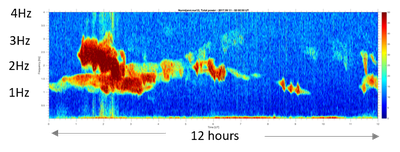Induction coil magnetometers
An induction coil magnetometer, also called a search coil magnetometer or pulsation magnetometer, is a passive instrument used for continuous monitoring of the different types of electromagnetic waves propagating on the ground level. A typical ground base induction coil station has at least two orthogonal coils on the ground in the horizontal plane. The induction coil magnetometer’s sensitivity and time resolution are higher than those of regular magnetometers used at geomagnetic observatories and more common magnetometer arrays.
The operation of the induction magnetometer is based on Faraday’s law of induction. A varying magnetic field induces a current in the coil, which is then amplified and monitored. To improve the sensitivity of the coil, the effective area which the magnetic field flux crosses is increased by increasing the number of coil turns. Also, special core material is used for the coil to improve performance by magnetic amplification. The coil design and core material have a big influence on the signal-to-noise ratio of the magnetometer. For geomagnetic observations, most designs have coil that are 0.5 to 2 meter long, with a diameter of approximately 10 cm.
The induction coil magnetometer is typically used for monitoring faster variations of the magnetic field, including different types of the geomagnetic pulsations such as electromagnetic ion cyclotron (EMIC) waves. Pulsations with longer periods may also be monitored with high quality observatory magnetometers. The induction coil magnetometer array gives information about the propagation conditions of the electromagnetic waves and about the source regions of these waves. It is also an excellent help for the interpretation of in-situ satellite observations of ULF-ELF waves by observing their foot-print at ground level, when the waves are not masked by ionosphere.
The global AC power networks radiate strong electromagnetic waves with a frequency of 50 and 60 Hz, which risk to saturate the instrument. Therefore, its upper cut-off frequency is set well below 50 Hz. That way, the lowest Schumann resonance modes at ~7.8 Hz, ~14 Hz and ~20 Hz generated by global lightning activity can be monitored. Low amplitude Alfvén modes, geomagnetic pulsations and higher Schumann resonances can be detected when a high-quality induction coil is used.
Installing the instrument in a remote location is important as it is sensitive to other man-made noise as well, besides the influence from power lines. Areas with dense infrastructure are usually electromagnetically noisy. Some man-made generated signals are widely observed. For example, the 16.67 Hz signal from the Swedish railway network is observed in the entire Finnish pulsation magnetometer network.

Figure 1: Induction coil without cover materials. The coil is 1 meter long and has 19,000 turns of copper wire around a mu-metal core.

Figure 2: Station set-up seen from above. The two induction coils pointing to North and East are installed 10 meters away from the electronics (square box). The coils are about 100 meters from the nearest building, where the signal is stored with high accuracy timing.
The output of the induction coils is usually presented as power spectrum images, showing amplitude versus frequency and time, for quick observations and event detection. Polarization ellipse calculated from the amplitude and phase of the two perpendicular coils give important information about the waves such as the direction of arrival and the direction of polarization rotation.
Figures 3 and 4 show a typical power spectrum for one calendar day in UTC, in which the different geomagnetic activity and various particular events are easily seen. The geomagnetic pulsation activity follows the solar cycles. Long term monitoring gives statistical information about phenomena. The Schumann resonance variations gives information about global lightning activity.

Figure 3: Daily total horizontal power spectrum from the induction coil. (A) Geomagnetic pulsations, (B) geomagnetic substorm, (C-D) 1st and 2nd Schumann resonances, (E) individual sferic (remote lightning strike), (F) 16.67 Hz signal from the Swedish railway network.

Figure 4: Long lasting continuous geomagnetic pulsation event (indicated with A in Figure 3) from multiple source regions recorded by the Finnish pulsation magnetometer station.
